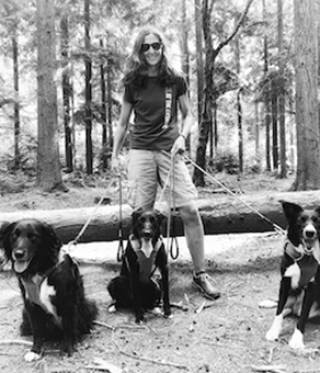- More about Professor Burningham
Qualifications
- DPhil Coastal Studies (2000): Morphodynamics of West Donegal Estuaries (DENI Distinction Award), University of Ulster
- BSc (1st Class Hons) Combined Science (1994): University of Lancaster/OSU
Employment
- 2021-present: Professor of Physical Geography, UCL Department of Geography
- 2018-2023: Vice Dean (Research), UCL Faculty of Social and Historical Sciences
- 2017-2021: Reader in Physical Geography, UCL Department of Geography
- 2013-2017: Senior Lecturer in Physical Geography, UCL Department of Geography
- 2001-2013: Lecturer in Physical Geography, UCL Department of Geography
- 2000: Tay Estuary Forum Project Officer, University of Dundee
- 1999: Countryside Ranger, East Lothian Council
- 1995: Countryside Ranger, East Kilbride Council
Affiliations
- British Society for Geomorphology
- Estuarine and Coastal Science Association
- Coastal Education and Research Foundation
- Coastal and Estuarine Research Federation
- American Geophysical UnionIrish Quaternary Association
- Irish Geomorphology Group
- Teaching
I teach on the following modules:
Undergraduate
- Geomorphology (GEOG0019)
- Coastal Geohazards (GEOG0034)
- Thinking Geographically I (GEOG0151)
Postgraduate
- Environmental GIS (GEOG0035)
- Models in Environmental Science (GEOG0109)
- Field Evidence of Environmental Change (GEOG0176)
- Publications
To view Professor Burningham's publications, please visit UCL Profiles:
- Research Interests

The central focus of my research is to explain coastal behaviour, system dynamics and mechanisms of forcing over decadal to century timescales. In particular, my research explores the relative importance of intrinsic system control versus external climate forcing on the geomorphology and morphodynamics of coastal sedimentary systems. I am also interested in understanding and capturing the geomorphological controls on coastal ecosystems.
Research projects
- Building Coastal Community Stewardship, in collaboration with the Deben Estuary Partnership [EA, Defra/AONB, UCL HEIF]
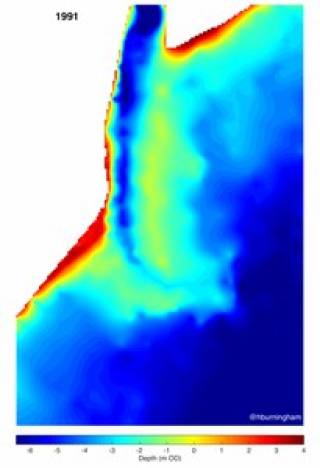
- The Guyana coast, catchment and marine observatory: data integration and analysis for monitoring of coastal dynamics, working with Dr T Oyedotun at the University of Guyana [AIS: Archipelagic & Island States Forum] Exchanging and Translating Coastal Knowledge and Understanding: improving access to and value of citizen science beach monitoring data [UCL HEIF]
- Imagining the measure of change: art, science and the estuary community [AHRC]
- Shoreline and shoreface dynamics on the Suffolk Coast [The Crown Estate]
- iCOASST - Integrating Coastal Sediment Systems [NERC]
- Environmental history, coastal geomorphology and morphodynamics of the west Donegal coast
- Identifying coastal archaeology using multispectral satellite imagery of the intertidal zone: a pilot study [English Heritage]
- Submarine geomorphology and historical dynamics of the greater Thames estuary [The Crown Estate; National Maritime Museum]
- Geomorphology and morphodynamics of mixed sediment inlets and tidal deltas
- Characterisation and prediction of large-scale coastal geomorphological behaviour [Environment Agency]
- Development and demonstration of systems-based estuary simulators (EstSim) [Defra/Environment Agency Flood and Coastal Defence R&D Programme]
Broader research interests
- Improving technologies for the measurement and monitoring of coastal systems
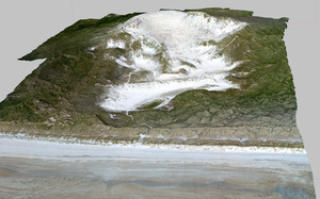
- Late-Holocene climate-forcing and human occupation of coastal dunes in northwest Ireland
- Coastal GIS and the analysis of historical shoreline and shoreface behaviour
- Estuary-coast interaction in the vicinity of tidal inlets
- Meso-tidal, high-wave energy beaches, sediment flux, and storm-driven beach-dune morphodynamics
- Coastal conservation and sustaining naturally functioning systems
- Impact

I work closely with coastal communities and stakeholders at my research sites in Suffolk (southeast England) and Donegal (northwest Ireland). I disseminate my research directly to those communities through a series of blogs and websites, and endeavour to be actively involved in local conversations around coastal monitoring and environmental governance.
Friends of Sheskinmore
With the help of Beacon Bursary funding from the UCL Public Engagement Unit, we launched Friends of Sheskinmore in 2013. As a collaborative community effort, we are local people, environmental / conservation managers, visitors and research scientists, brought together by our common interest in the natural history, environmental change and management of Sheskinmore Nature Reserve specifically, and the west Donegal coast more generally.
Friends of Sheskinmore aims to:
- draw together local knowledge of, interest in and enthusiasm for the natural history of a site of national and international importance on the northwest coast of Ireland
- foster a unique collaboration between natural and social scientists through public engagement.
A key external-facing aspect of Friends of Sheskinmore is the website and blog where all those interested in natural and environmental change on the west Donegal coast can share in and contribute to knowledge, understanding and enquiry. We currently have 5 main contributing authors, and several others providing supporting information. We also share updates through Twitter and have a strong and active following on Facebook where visitors freely post photos and observations from the site.
We actively engage in informal and formal monitoring and observation from across the Sheskinmore site and beyond; we organise walks across Sheskinmore and talks at the NPWS Field Centre at McGlincheys. The website also provides a focus on reporting data from the weather station I set up locally in 2012, and data collected from a network of water level recorders installed across the Sheskinmore dune and wetland system, in addition to other management and research activities that we can report on. We had over 3000 visitors to the website in 2019 from 50 different countries.
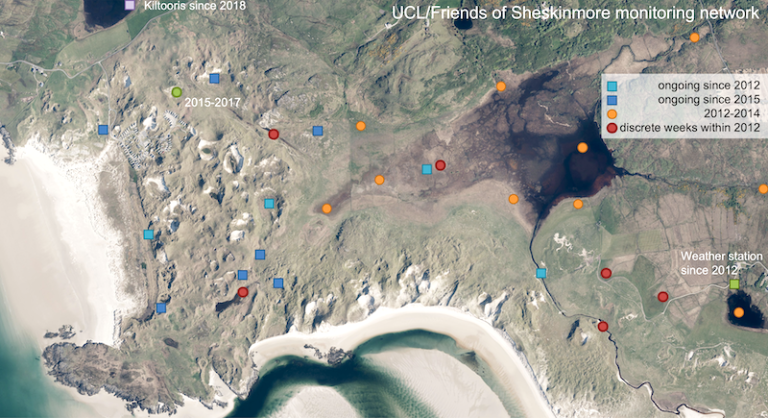
Suffolk Inlets
Since 2019, I have been disseminating thoughts and findings from my ongoing research on the dynamics of the Suffolk inlets through a blog that is shared between maritime stakeholders. Specifically, the website provides up-to-date commentary on the changing position of the banks within the Deben inlet, derived from near- (drone) and remote- (satellite) sensing imagery and data. The site provides those navigating the inlet a new perspective on the dynamics of the bank system and the factors driving the movement of the shoals and channel. It has also encouraged collaboration with local drone owners who frequently offer imagery and video to support the monitoring and increasing record of Deben inlet dynamics.
My work on the Deben inlet was featured in the Life on the Deben film, a feature-length documentary exploring the history, society and science of the Deben river and estuary, narrated and presented by John McCarthy, filmed and directed by Tim Curtis, and produced by Malcolm Hodd. I was interviewed for the film, and feature in the latter stages detailing the coastal dynamics that I have been researching since the mid-2000s. Released in December 2017 with the premiere in the Riverside Theatre, Woodbridge, the film has since toured cinemas in Suffolk, accruing a total cinema audience of 15,000+. A DVD of the film has also been released, with sales of 6000+, and a related book, also featuring my research on the Deben estuary, was published in November 2019.
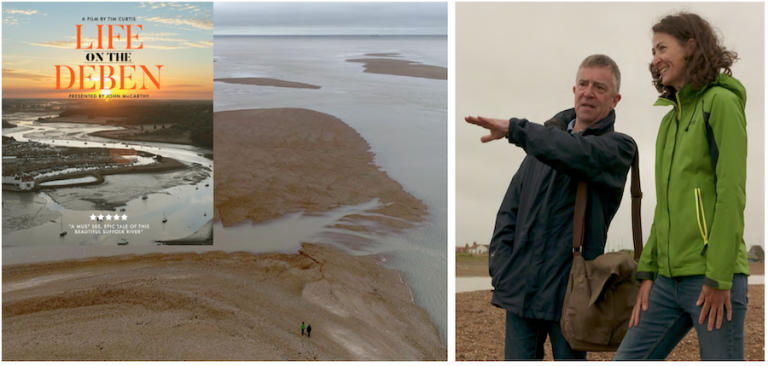
Deben Soundings
My recent AHRC-funded project, in association with artist and academic Simon Read (Middlesex University), focuses on developing networks that deliver an art-science approach to environmental decision-making. The project runs through 2020-2022, primarily through a series of engagement activities that bring the network of stakeholders (local community, managers, engineers, scientists, researchers) together to explore aspects of change, values, and management of the Deben estuary landscape.
A key aspect of the project is that we are working alongside the Deben Estuary Partnership in their review of the 2015 Estuary Plan and the progression of a new Estuary Plan for 2021/2022. The project seeks to provide a number of arenas where disparate knowledge, experiences, and views are welcome, and where evidence and enquiry relating to the changing landscape of the Deben are engaged through a variety of art-sciences approaches. The whole stakeholder community, no matter their background, knowledge or understanding, should be able to engage in discussions informing environmental governance.
- Research Students

PhD research opportunities
I am keen to hear from students interested in progressing to a PhD related to:
- Coastal dynamics and forcing of coastal change
- Complex interactions between geomorphology, hydrology and ecology in the coastal zone
- Community initiatives for monitoring coastal change and informing coastal management
We currently have the following specific opportunities available:
- Late-Holocene forcing of coastal change
Please explore the funding pages for more information about fees and funding.
Current PhD students
- Trista Chang - Vulnerability of coastal dune wetlands
- Jie Gong - The role of tidal inlets in flood and coastal erosion risk and management
- Awa Bousso Dramé - Cross-border coastal inlet dynamics - impacts of anthropogenic developments on coastal systems resilience (UCL ORS 2020-; Faculty for the Future 2020)
- Silvia Polizel - Morphodynamics of Brazilian deltas (CNPq Brazil 2019-)
- Honeyeh Iravani - Assessment of the impacts of climate change, water resource developments and land cover change on Iranian wetlands (Self-funding 2018-)
Completed PhD Students
- Varandas Martins S (2019) Ecohydrology of temporary ponds (NERC) [supervised also by Dr C Pinto-Cruz (Evora) and Dr Carl Sayer]
- Schembri M (2018) Aspects of embayed beach morphology in a micro-tidal setting in Malta (Malta Government Scholarship) [supervised also by Professor Jon French]
- Fernandez Nunez M (2016) Fusion of airborne LiDAR, multispectral imagery and spatial modelling for understanding saltmarsh response to sea-level rise (Talentia) [supervised also by Prof J Ojeda (Sevilla) and Professor Jon French]
- Price D (2016) Influence of vegetation on sediment accumulation in tidal saltmarshes: an integrated field and modelling study [supervised also by Professor Jon French]
- Gardner E (2016) The ecohydrology and conservation of a coastal sedimentary lake and wetland system: Sheskinmore Lough, Donegal, Ireland (UCL) [supervised also by Dr Julian Thompson]
- Mitchell L (2015) An assessment of rehabilitation gravels for Salmo trutta spawning: a case study from a small chalk stream, the River Stiffkey, North Norfolk (EA/Cefas) [supervised also by Dr Carl Sayer]
- Duranel A (2015) Hydrology and hydrological modelling of acidic mires in Central France (NERC) [supervised also by Dr Julian Thompson]
- Pylarinou A (2015) Impacts of climate change on UK coastal and estuarine habitats: a critical evaluation of the sea level affecting marshes model (SLAMM) [supervised also by Professor Jon French]
- Oyedotun T (2015) Estuary-coast interaction and morphodynamic evolution: a comparative analysis of three estuaries in southwest England (Nigerian Government Education Trust Fund) [supervised also by Professor Jon French]
- Barrett-Mold C (2013) Morphostratigraphy of marginal coastal environments (NERC) [supervised also by Professor Jon French]
- Morales-Marin L (2013) Numerical modelling of hydrodynamics and sedimentation in upland lakes: a test of the sediment focusing hypothesis (UCL) [supervised also by Professor Jon French]
Completed Masters Students
MSc Aquatic Conservation, Ecology and Restoration / Aquatic Science / Freshwater and Coastal Sciences
- 2021 A Biological Evaluation of Urban River Restoration: The Impacts of the Restoration of Beverley Brook on the Diversity and Community Composition of Aquatic Macroinvertebrates
- 2019 Runoff Attenuation Features (RAFs) to mitigate flood risk and improve water quality
- 2015 Substrate history of southeast England seabed
- 2008 Physical characterisation and differentiation of visually identified flow biotopes
- 2008 Changes in ecohydraulics with restoration: the River Glaven, Norfolk
- 2007 Evaluation of Shotley Foreshore Recharge
- 2007 The morphosedimentary character of Orford Haven, Suffolk
- 2006 Grain size trend analysis in a gravel-dominated ebb-tidal delta
MSc Climate Change
- 2021 Coastal dune mobility in Co. Donegal, Ireland: Unravelling the importance of climate and human activity
- 2020 Investigating the Sensitivity of Sediment Transport
- 2018 Nearshore wave climate variability at Bacton
- 2017 The North Atlantic Oscillation as a tool to predict future extreme windstorm events
- 2017 Late-Holocene environmental change in northwest Ireland
- 2017 Relationship between NAO and wind climate in western Europe
- 2016 Impact Southern Oscillation on embayment beach rotation, NSW, Australia
- 2013 Sea level change: exploring evidence for a late-Holocene highstand
- 2013 The relationship between the NAO and wind climate over Norway
MSc Conservation
- 2020 Underwriting change: examining roles, rules and the road ahead for incumbent actors in debt capital markets in the transition to sustainable finance
- 2019 The potential of UAS imagery for saltmarsh vegetation classification and conservation
- 2019 Predictive capacity of Ecopath with Ecosim: a global sensitivity analysis
- 2013 The extent and cause of unwelcome species on sand dunes
- 2011 Public perceptions and values of ecosystem services
- 2011 Landscape connectivity of local food and energy production
- 2011 Mitigation strategies for the new high-speed rail route
- 2010 The altitudinal ecology of Apteryx australis
- 2010 Oviposition and habitat requirements of the Small Blue (Cupido minimus)
- 2010 Evaluating Natura 2000; a case study of Sheskinmore Lough SPA in Ireland
- 2010 Dune heath habitats of northwest Ireland
- 2009 The impact of artificial lighting on the commuting and foraging behaviour of bats
- 2009 Control of invasive species in San Francisco natural areas
- 2009 The effect of Common Standards Monitoring on Lepidoptera
- 2009 Naturally regenerated calcareous grasslands on former arable land
- 2008 Developing a wider countryside common insects monitoring method for volunteers
- 2008 Ecological impacts of deer browsing on ground flora
- 2008 The potential to restore a plantation on ancient woodland at Roudsea NNR
- 2008 Invasion and clearance of sea buckthorn (Hippophae rhamnoides) on dunes
- 2007 Bats in Greater London: A revisit to London's bat feeding area survey
- 2007 Geomorphological control on coastal dune plant species
- 2007 A rapid assessment of the avifauna of Isla Del Rey, Las Perlas Archipelago, Panama
- 2006 Spatiotemporal movement of wildlife through the Bow Valley Wildlife Corridors
- 2006 Long-term changes in flora and structure of Monks Wood
- 2006 River Thames intertidal substrate habitat management and conservation
- 2005 Bat mitigation: a preliminary investigation into the success of replacement bat roosts
- 2005 Factors affecting the distribution of Hypericum linariifolium
- 2005 Biological / anthropogenic determinants of spatial variation in primate abundance
- 2005 Uptake and implementation of coastal habitat creation agri-environment schemes
- 2005 Bird foraging preferences in response to arable field management strategies
- 2004 The implications of climate change for the conservation of native pine woodland
- 2004 The response of ground flora to changes in silvicultural systems
- 2004 Common lizard (Lacerta vivipara) populations on the Isle of Man
- 2004 Impact of litter management strategies on strandline eco-morphodynamics
- 2004 Habitat requirements and oviposition of the Small Heath butterfly
- 2003 Abundance and extinction rates amongst the Lemurs of Madgascar
- 2003 Habitat use by Skylarks (Alauda arvensis) on a lowland arable farm
- 2003 Black Grouse breeding success and habitat management
- 2003 Habitat requirements of the Small Heath (Coenonympha pamphilus)
- 2003 Vocal individuality of the Reed Bunting (Emberiza schoeniclus)
MSc Environmental Modelling
- 2021 The significance of peat deposits on barrier morphology and the impact on wave dynamics and sediment transport: A case study of the North Suffolk coast
- 2020 The impact of ebb-tidal deltas on waves and longshore sediment transport
- 2020 Impact of rapid urbanization on Land Use and Land Cover Change in Guangdong, China
- 2018 Impact of climate variability on beach behaviour in northwest Ireland
- 2015 Re-evaluation of river restoration on the River Darent
MSc Remote Sensing and Environmental Mapping
- 2020 Shoreline Change and Hurricanes: the ultimate affair
- 2020 Quantitative Difference Analysis of Point Clouds of a Boulder Coast
- 2018 Object-oriented and pixel-based classification of high-resolution UAS imagery
- 2017 Creating high-resolution topographic models using low-cost consumer-grade UAVs
- 2016 Relationship between ENSO and wind climate over the western North Pacific
- 2016 Vegetation evolution on coastal dunes, northwest Ireland
- 2015 Saltmarsh change analysis of Alde-Ore estuary 2006-2011
- 2013 Geomorphic and hydrological mapping of Sheskinmore Lough
- 2012 Ecogeomorphic feedbacks in coastal dune blowouts
- 2012 Reconstructing the geographical history of watersheds
- 2012 Modelling the influence of offshore banks on nearshore waves
- 2010 User of LiDAR elevation data to assess the potential for managed realignment
 Close
Close


